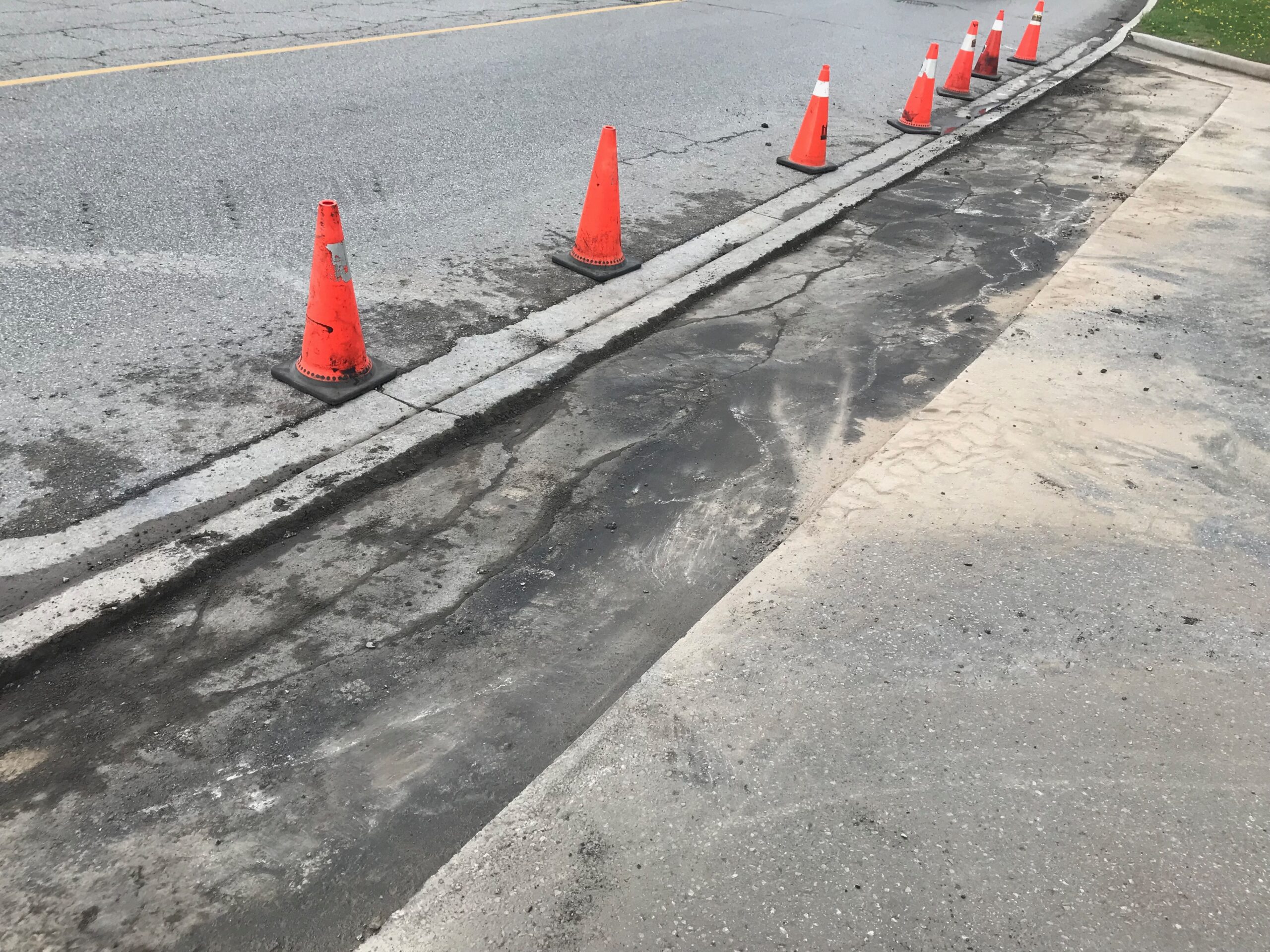
What Is Asphalt Raveling?
In a nutshell, asphalt raveling occurs when small crack formations expand and allow water and debris to permeate the surface of the pavement. As the cracks continue to expand over time, small particles of aggregate break apart and eventually compromise the foundation of the pavement. Over time, the broken pieces of aggregate become bigger and bigger until potholes start to form.
Causes of Asphalt Raveling
There are numerous factors that can lead to raveling in asphalt pavement, either by themselves or in conjunction with one another. These causes include the following: inadequate compaction during construction; aggregate segregation; poor mix design; installation during wet weather; dust coating; and dislodging from heavy traffic.
Inadequate Compaction
Proper aggregate compaction is essential when laying a strong structural foundation for any asphalt driveway or parking lot. Hot mix asphalt must be applied at a minimum of 290℉/98°C in order for it to sufficiently bond with the ground on which it’s being laid during the compaction process. If the temperature is lower than that, then the compaction will be weak and unstable. Most professional contractors utilize non-contact thermometers to measure the temperature of the ground and ensure it’s at an appropriate level.
Aggregate Segregation
To a certain degree, aggregate segregation is a naturally occurring phenomenon in asphalt pavement infrastructure as a result of the varying sizes, shapes, and densities of the underground particles. But when segregation becomes too expansive, it can ultimately weaken the functionality of the binding agent and cause pieces of the aggregate to separate from the whole. When the fine particles become detached from the rest of the aggregate matrix, the binding agent struggles to hold together the larger portions of the coarse particles due to the weakened foundation and the abundance of empty, unsupported spaces in between.
Poorly Formulated Aggregate Mix
A number of crucial factors must be taken into account when creating a viable aggregate mixture including the local climate, current temperatures, local traffic, and the type of property on which the aggregate or hot asphalt mixture is being applied. Areas that typically encounter heavier foot or vehicular traffic inevitably require a much more potent mixture that can withstand the weight and pressure of multiple heavy large vehicles at any given time, without the risk of collapsing or caving in. Seasonal weather patterns should also be taken into strong consideration when formulating aggregates for certain locations.
Moisture in the Ground
Although small levels of moisture in the air and ground are acceptable when installing fresh asphalt aggregates, too much moisture can actually prevent the binding agent from doing its job. That’s why professional asphalt contractors typically avoid laying fresh asphalt on rainy, snowy, or extremely humid days and wait until the temperatures are a little cooler.
Dust Coating
If the aggregate is improperly applied and maintained, it can get dirty and covered in dust. When this happens, it makes it impossible for the binding agent to form a strong and durable bond with the aggregate. Instead, the binding agent tends to stick to the top layer of dust, which is the initial point of contact. Over an extended period of time and with continued use, the fine and large aggregates will eventually crumble under the pressure of vehicular and foot traffic.
Traffic Dislodging
In particularly busy and high-traffic locations, asphalt raveling repairs will be needed more frequently regardless of the quality and durability of the aggregate. This is because of how often they’re used and all the different damaging elements to which they’re exposed on a regular basis.
[button size=”medium” style=”primary single-post-btn skew-button” text=”Get a Free Consultation Now!” link=”Contact Us” target=””]
Tips to Prevent Asphalt Raveling
Proper asphalt maintenance is a big part of protecting your pavement from the unavoidable damaging elements that are presented by the world. In light of this fact, here are a few tips for preventing your asphalt from raveling:
Track the Temperature of the Aggregate
Measuring the temperature of your asphalt on a regular basis will help you to better identify potential issues before they occur and take the appropriate preventative actions. You can use a non-contact thermometer to measure the internal and surface temperature of the pavement.
Mix Design and Binder Content
As mentioned, different climates and regions require specifically formulated aggregates and binder content to allow your pavement to function optimally and last longer without wearing down. Make sure you hire a local professional contractor who uses the highest-quality materials and installation practices in your area.
Keep Your Aggregate Clean
Removing all dust particles and other debris from your aggregate and preventing exposure to harmful elements is crucial to keeping it fresh and fully functional for longer periods of time. As previously mentioned, dust coatings and other dirt can create a barrier between the binding agent and the aggregate, which will prevent them from forming a strong bond. As a result, the foundation of your aggregate will be brittle and susceptible to damage from the moment it’s installed.
Regularly Scheduled Maintenance
All of the abovementioned tips for preventing asphalt raveling are part of regularly scheduled maintenance. You should have a professional asphalt contractor examine your pavement at least once a year to ensure there isn’t any impending and potentially costly damage. They’ll be able to pinpoint weak spots and other structural inconsistencies right away.
Contact Sure-Seal Pavement Maintenance Inc. for Asphalt Repair in the GTA
The asphalt installation, maintenance, and repair experts at Sure-Seal Maintenance Inc. have been working in the Toronto and GTA market for over 20 years. As a testament to the high quality of our work and the materials we use, we offer a minimum seven-year warranty on all of our projects. For more information on our asphalt raveling repair services, or to book a complementary consultation, please contact us today!
Photo Credit: iStock.com/:pavelalexeev

